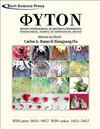Land equivalent ratio, grain and pod yield and ethereal extract of Helianthus annuus L. in monoculture and associated with Pisum sativum L. in function of stabilized urea.
IF 1.3
4区 生物学
Q3 PLANT SCIENCES
Phyton-international Journal of Experimental Botany
Pub Date : 2016-05-16
DOI:10.32604/phyton.2014.83.101
引用次数: 0
Abstract
The aim of this study was to assess the land equivalent ratio, biomass, grain yield and ethereal extract of Helianthus annuus in monoculture and associated with Pisum sativum in function of stabilized urea (0, 40, 80 kg N/ha) in El Cerrillo, Mexico. It was also estimated pod yield obtained by P. sativum as a pure stand and associated with H. annuus. The six treatments (in each experiment) were evaluated in a 2 × 3 factorial experiment in a randomized complete block design with four replications. When F values were significant, the honestly significant difference test at the 5% level of significance was used. The principal component analysis was also used to study the interrelationship among the six treatments and seven variables. The results observed in the biplot indicated that the largest original variation in the data was adequately represented in the first two principal components since both accumulated 87.9%. This analysis revealed that the treatments of H. annuus in monoculture and H. annuus + P. sativum fertilized with 80 kg N/ha were those which achieved the highest grain yields (287.7 and 285 g/m2, respectively). The superiority of these treatments is attributed to the fact that leaf area index and total biomass showed to be the main yield component of H. annuus. The value of the land equivalent ratio (1.47) obtained with the supply of 80 kg N/ha indicates an advantage in the grain and pod yields of the association of both species by 47% over their respective monocultures. As a result, this planting system is a good choice for farmers with scarce economic resources in the region.单作向日葵的土地当量比、籽粒和荚果产量及籽粒提取物及其对稳定尿素的影响。
研究了稳定尿素(0、40、80 kg N/ha)对墨西哥El Cerrillo单作向日葵(Helianthus annuus)和油菜(Pisum sativum)的土地当量比、生物量、籽粒产量和提取物的影响。此外,还估算了作为纯林分的sativum与H. annuus的荚果产量。采用随机完全区组设计,4个重复,采用2 × 3析因试验对6个处理(每个试验)进行评价。当F值显著时,采用5%显著性水平下的诚实显著性差异检验。采用主成分分析研究了6个处理和7个变量之间的相互关系。在双标图中观察到的结果表明,数据中最大的原始变化在前两个主成分中得到充分体现,因为它们都累积了87.9%。结果表明,单作和施氮量为80 kg / hm2的黄杨+黄杨产量最高,分别为287.7 g/m2和285 g/m2。这些处理的优势在于叶面积指数和总生物量是黄杨产量的主要组成部分。在80 kg N/ha条件下获得的土地当量比(1.47)表明,两种组合的籽粒和豆荚产量比各自的单一栽培高出47%。因此,这种种植制度是该地区经济资源稀缺的农民的一个很好的选择。
本文章由计算机程序翻译,如有差异,请以英文原文为准。
求助全文
约1分钟内获得全文
求助全文
来源期刊
CiteScore
1.90
自引率
11.80%
发文量
17
审稿时长
12 months
期刊介绍:
Phyton-International Journal of Experimental Botany is an international journal that publishes on the broadest aspects of plant biology and ecology. The journal welcomes the original and exciting submissions that provide new and fundamental insights into the origins, development, and function of plants from the molecular to the whole organism and its interactions within the biotic and abiotic environment. Phyton-International Journal of Experimental Botany publishes outstanding research in the plant and ecology sciences, especially in the areas of plant physiology and biochemistry, plant metabolism, plant ecology and evolution, as well as those making use of synthetic, modeling, bioinformatics, and -omics tools. Manuscripts submitted to this journal must not be under simultaneous consideration or have been published elsewhere, either in part or in whole.

 求助内容:
求助内容: 应助结果提醒方式:
应助结果提醒方式:


